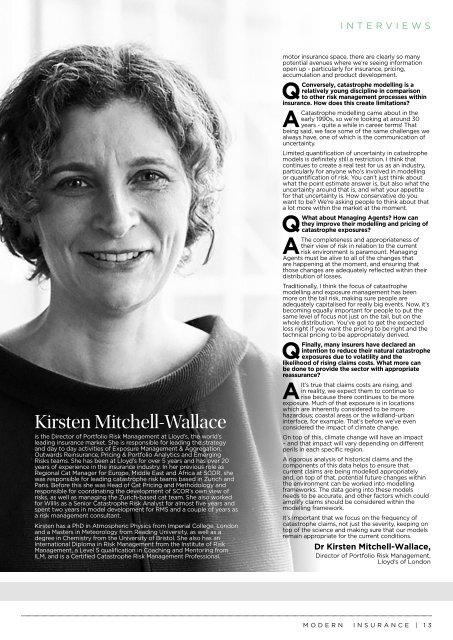Modern Insurance Magazine Issue 60
This issue features... Insight: Every Cloud Has A Silver Lining, by Tim Yeates, Co-Founder, Carbon1 Ltd. Interview: Modelling Modern Risk with Dr Kirsten Mitchell-Wallace, Director of Portfolio Risk Management, Lloyd’s of London Interview: Searching for Answers with Iain Willis, Research Director, Gallagher Research Centre Editorial Board: Find out what our editorial board panel of experts have to say in this edition of Modern Insurance Magazine A Final Word with Steve White, Chief Executive, British Insurance Brokers' Association (BIBA) Is it time for Risk Managers to rethink their role in the Climate Crisis? by François Lanavère, Head of Strategic Partnerships, AXA Climate Associations Assemble: Modern Insurance’s panel of resident associations outline the burning issues in insurance Just a Thought with Eddie Longworth - Building Trust through Responsible AI in Claims: Championing a Voluntary Code of Conduct Making Efficiency Gains in Subsidence Claims, by Chris Carlton MRICS, New Business & Key Account Director, Geobear Chemistry for a Sustainable Future: Q&A with Grant Dempsey, Sales Manager - Distribution, BASF Automotive Refinish UK & Ireland Industry Collaboration: Working together to provide the best mobility solution, with James Roberts, Business Development Director, Insurance, Europcar Mobility Group UK Thinking Upside Down: Mind the Protection Gap, by Ashley Preece, Product Owner, Claim Technology In Conversation with… Neil Garrett, UK, South Africa & Nordics Sales Director, Solera | Audatex A New Climate for Claims, from I Love Claims / ARC 360 10 Mins with… Ola Jacob, Independent Insurance Advisor In Celebration: Modern Claims Awards 2023 Insur.Tech.Talk - Interviews with Stephen Weinstein, Former Chair of the Bermuda Business Development Agency; Bill Churney, President, Extreme Event Solutions, Verisk; Jacqui LeGrand, CEO, Maptycs; Heather H. Wilson, Chief Executive Officer, CLARA Analytics Insur.Tech.Talk Editorial Board - Experts from within the insurtech sector and beyond join us once more to share their unique insights!
This issue features...
Insight: Every Cloud Has A Silver Lining, by Tim Yeates, Co-Founder, Carbon1 Ltd.
Interview: Modelling Modern Risk with Dr Kirsten Mitchell-Wallace, Director of Portfolio Risk Management, Lloyd’s of London
Interview: Searching for Answers with Iain Willis, Research Director, Gallagher Research Centre
Editorial Board: Find out what our editorial board panel of experts have to say in this edition of Modern Insurance Magazine
A Final Word with Steve White, Chief Executive, British Insurance Brokers' Association (BIBA)
Is it time for Risk Managers to rethink their role in the Climate Crisis? by François Lanavère, Head of Strategic Partnerships, AXA Climate
Associations Assemble: Modern Insurance’s panel of resident associations outline the burning issues in insurance
Just a Thought with Eddie Longworth - Building Trust through Responsible AI in Claims: Championing a Voluntary Code of Conduct
Making Efficiency Gains in Subsidence Claims, by Chris Carlton MRICS, New Business & Key Account Director, Geobear
Chemistry for a Sustainable Future: Q&A with Grant Dempsey, Sales Manager - Distribution, BASF Automotive Refinish UK & Ireland
Industry Collaboration: Working together to provide the best mobility solution, with James Roberts, Business Development Director, Insurance, Europcar Mobility Group UK
Thinking Upside Down: Mind the Protection Gap, by Ashley Preece, Product Owner, Claim Technology
In Conversation with… Neil Garrett, UK, South Africa & Nordics Sales Director, Solera | Audatex
A New Climate for Claims, from I Love Claims / ARC 360
10 Mins with… Ola Jacob, Independent Insurance Advisor
In Celebration: Modern Claims Awards 2023
Insur.Tech.Talk - Interviews with Stephen Weinstein, Former Chair of the Bermuda Business Development Agency; Bill Churney, President, Extreme Event Solutions, Verisk; Jacqui LeGrand, CEO, Maptycs; Heather H. Wilson, Chief Executive Officer, CLARA Analytics
Insur.Tech.Talk Editorial Board - Experts from within the insurtech sector and beyond join us once more to share their unique insights!
You also want an ePaper? Increase the reach of your titles
YUMPU automatically turns print PDFs into web optimized ePapers that Google loves.
INTERVIEWS<br />
Kirsten Mitchell-Wallace<br />
is the Director of Portfolio Risk Management at Lloyd’s, the world’s<br />
leading insurance market. She is responsible for leading the strategy<br />
and day to day activities of Exposure Management & Aggregation,<br />
Outwards Reinsurance, Pricing & Portfolio Analytics and Emerging<br />
Risks teams. She has been at Lloyd’s for over 5 years and has over 20<br />
years of experience in the insurance industry. In her previous role as<br />
Regional Cat Manager for Europe, Middle East and Africa at SCOR, she<br />
was responsible for leading catastrophe risk teams based in Zurich and<br />
Paris. Before this she was Head of Cat Pricing and Methodology and<br />
responsible for coordinating the development of SCOR’s own view of<br />
risks, as well as managing the Zurich-based cat team. She also worked<br />
for Willis as a Senior Catastrophe Risk Analyst for almost five years and<br />
spent two years in model development for RMS and a couple of years as<br />
a risk management consultant.<br />
Kirsten has a PhD in Atmospheric Physics from Imperial College, London<br />
and a Masters in Meteorology from Reading University, as well as a<br />
degree in Chemistry from the University of Bristol. She also has an<br />
International Diploma in Risk Management from the Institute of Risk<br />
Management, a Level 5 qualification in Coaching and Mentoring from<br />
ILM, and is a Certified Catastrophe Risk Management Professional.<br />
motor insurance space, there are clearly so many<br />
potential avenues where we’re seeing information<br />
open up - particularly for insurance, pricing,<br />
accumulation and product development.<br />
QConversely, catastrophe modelling is a<br />
relatively young discipline in comparison<br />
to other risk management processes within<br />
insurance. How does this create limitations?<br />
ACatastrophe modelling came about in the<br />
early 1990s, so we’re looking at around 30<br />
years - quite a while in career terms! That<br />
being said, we face some of the same challenges we<br />
always have, one of which is the communication of<br />
uncertainty.<br />
Limited quantification of uncertainty in catastrophe<br />
models is definitely still a restriction. I think that<br />
continues to create a real test for us as an industry,<br />
particularly for anyone who’s involved in modelling<br />
or quantification of risk. You can’t just think about<br />
what the point estimate answer is, but also what the<br />
uncertainty around that is, and what your appetite<br />
for that uncertainty is. How conservative do you<br />
want to be? We’re asking people to think about that<br />
a lot more within the market at the moment.<br />
QWhat about Managing Agents? How can<br />
they improve their modelling and pricing of<br />
catastrophe exposures?<br />
AThe completeness and appropriateness of<br />
their view of risk in relation to the current<br />
risk environment is paramount. Managing<br />
Agents must be alive to all of the changes that<br />
are happening at the moment, and ensuring that<br />
those changes are adequately reflected within their<br />
distribution of losses.<br />
Traditionally, I think the focus of catastrophe<br />
modelling and exposure management has been<br />
more on the tail risk, making sure people are<br />
adequately capitalised for really big events. Now, it’s<br />
becoming equally important for people to put the<br />
same level of focus not just on the tail, but on the<br />
whole distribution. You’ve got to get the expected<br />
loss right if you want the pricing to be right and the<br />
technical pricing to be appropriately derived.<br />
QFinally, many insurers have declared an<br />
intention to reduce their natural catastrophe<br />
exposures due to volatility and the<br />
likelihood of rising claims costs. What more can<br />
be done to provide the sector with appropriate<br />
reassurance?<br />
AIt’s true that claims costs are rising, and<br />
in reality, we expect them to continue to<br />
rise because there continues to be more<br />
exposure. Much of that exposure is in locations<br />
which are inherently considered to be more<br />
hazardous; coastal areas or the wildland-urban<br />
interface, for example. That’s before we’ve even<br />
considered the impact of climate change.<br />
On top of this, climate change will have an impact<br />
– and that impact will vary depending on different<br />
perils in each specific region.<br />
A rigorous analysis of historical claims and the<br />
components of this data helps to ensure that<br />
current claims are being modelled appropriately<br />
and, on top of that, potential future changes within<br />
the environment can be worked into modelling<br />
frameworks. The data going into these models<br />
needs to be accurate, and other factors which could<br />
amplify claims should be considered within the<br />
modelling framework.<br />
It’s important that we focus on the frequency of<br />
catastrophe claims, not just the severity, keeping on<br />
top of the science and making sure that our models<br />
remain appropriate for the current conditions.<br />
Dr Kirsten Mitchell-Wallace,<br />
Director of Portfolio Risk Management,<br />
Lloyd’s of London<br />
MODERN INSURANCE | 13

















